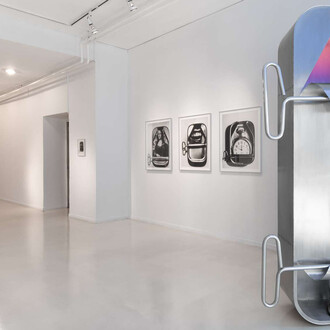A book's dust jacket is in essence its "poster", a visual image carrying the book's message. As we look at books, read them and buy them, they become our possessions and objects we care about, and that makes their physical appearance an especially important factor. A good book design has the power to speak out to readers, to capture their attention and to persuade them. Yet despite being the first point of contact with the reader, the dust jacket has been fairly nondurable. It often becomes torn, damaged or lost. Edvard Ravnikar wrote in 1952 that "a book that loses its dust jacket more often than not becomes blind and deaf". He advocated the idea that all parts of a book, including covers and spine, should be carefully designed into a permanent entity. Early 1950s mark the beginning of quality book design in Slovenia, spurred on by, mostly Ravnikar's, critique of book designs. Prominent dust jacket designers of the post-war period, among them Uroš Vagaja, Grega Košak, Jože Brumen, Bronislav Fajon, Jakica Accetto, Nadja Furlan, Majda Dobravec and others, conscientiously took on the task to establish a modern graphic design idiom. They embarked on the exploration of a possible more liberal and sophisticated authorial expression. An important part in this endeavour was played by publishing houses (Cankarjeva založba, Založba Obzorja, Državna založba Slovenije, Založba Lipa, etc.) which were aware of the importance of a good book design and engaged visionary young designers for the job.
After the Second World War Edvard Ravnikar, a professor at the Ljubljana Faculty of Architecture, played the key role in the education of young architects who laid the foundations of modern Slovenian graphic design. It was precisely Ravnikar's 1951 design of the dust jacket and covers for the Slovenian edition of Ignazio Silone's Fontamara, published by Cankarjeva založba, that represented a milestone in the development of modern design concept. What was new about his design was the concept of the dust jacket design in which Ravnikar joined the abstract, rasterised and stylised shapes and the handwritten title into an aesthetically sophisticated, coherent and communicative whole, thereby satisfying modernist requirements for the integration of form and function.
Slovenian graphic designers were influenced by both Swiss International Style (grid system, use of typefaces as an artistic form of expression, etc.) and the elements of fine art (abstract art, Art Informel). They combined elements of (geometric) abstract art with rationalistic, geometricised and structured analytical compositions. A multilayered narrative expression, based on simple graphic shapes, abstract language of the fine arts, overlapping stylised figures and objects, and a collage of coloured layers, is a characteristic of Slovenian graphic design that is typical of dust jacket design as well. Grega Košak, for example, designed geometrical, colour-coherent dust jackets featuring overlapping stylised motifs and used (mainly in the 1960s) photography and typeface as elements of visual expression. In the same period, an important (but fairly overlooked) contribution to the dust jacket design was made by designers Jakica Accetto, Nadja Furlan and Majda Dobravec, who already in the 1950s started contributing their designs for the publishing houses Cankarjeva založba and Državna založba Slovenije. Also active in the book design of the 1950s and 1960s was the architect Uroš Vagaja who based his visual message on illustration and collage and the use of photography. His graphic language is (figurally) playful and colourfully diverse. He uses typeface as expressive visual elements mirroring the contents of the book.
An important novelty in dust jacket design was introduced by Jože Brumen in 1963 with his series of dust jacket designs for Državna založba Slovenije publishing house (Slovene editions of War and Peace, Cousin Pons, Hamlet, Macbeth, Othello). His jackets are uniform designs in the sense that the image stretches across the entire jacket, including the flaps. Applying it to the dust jacket, Brumen highlighted the longitudinal movement and the intimacy of contemplation while reading. Brumen's 1960s dust jacket designs made a key contribution to the establishment of original, modern book design.
Another designer to have made an important contribution to book design in the 1960s was Bronislav Fajon. His dust jackets are often composed of iridescent graphic structures, collage and photographic rasters. Between 1966 and 1968, Karel Hrovatin designed dust jackets for Mozaik, an imprint of the Cankarjeva založba publishing house. He built his visual expression by using elements of abstract painting, photography and collage on the white background of the jacket.
Working throughout the 1950s to establish a quality artistic appearance of book dust jackets, designers have shown that simple, abstract artistic elements can go a long way towards establishing an effective visual message. In the 1960s, applying new, original approaches, and increasingly using photography, they went one step further and paved the way for a new kind of visual expression. A diverse mix of authorial approaches brought about a multitude of quality solutions that made a rich contribution both to the Slovenian publishing business and to the development of Slovenian graphic design.
The Museum of Architecture and Design holds a rich collection of dust jackets from the second half of the 20th century. The exhibition shows more than fifty dust jackets and books wrapped in dust jackets designed in 1950s and 1960s. The authors of the exhibited works are Uroš Vagaja, Grega Košak, Jože Brumen, Bronislav Fajon, Jakica Accetto, Karl Hrovatin, Oton Polak, Nadja Furlan, Majda Dobravec, Zvest Apollonio, Radmila Novak - Ciuha in Vladimir Makuc.
















